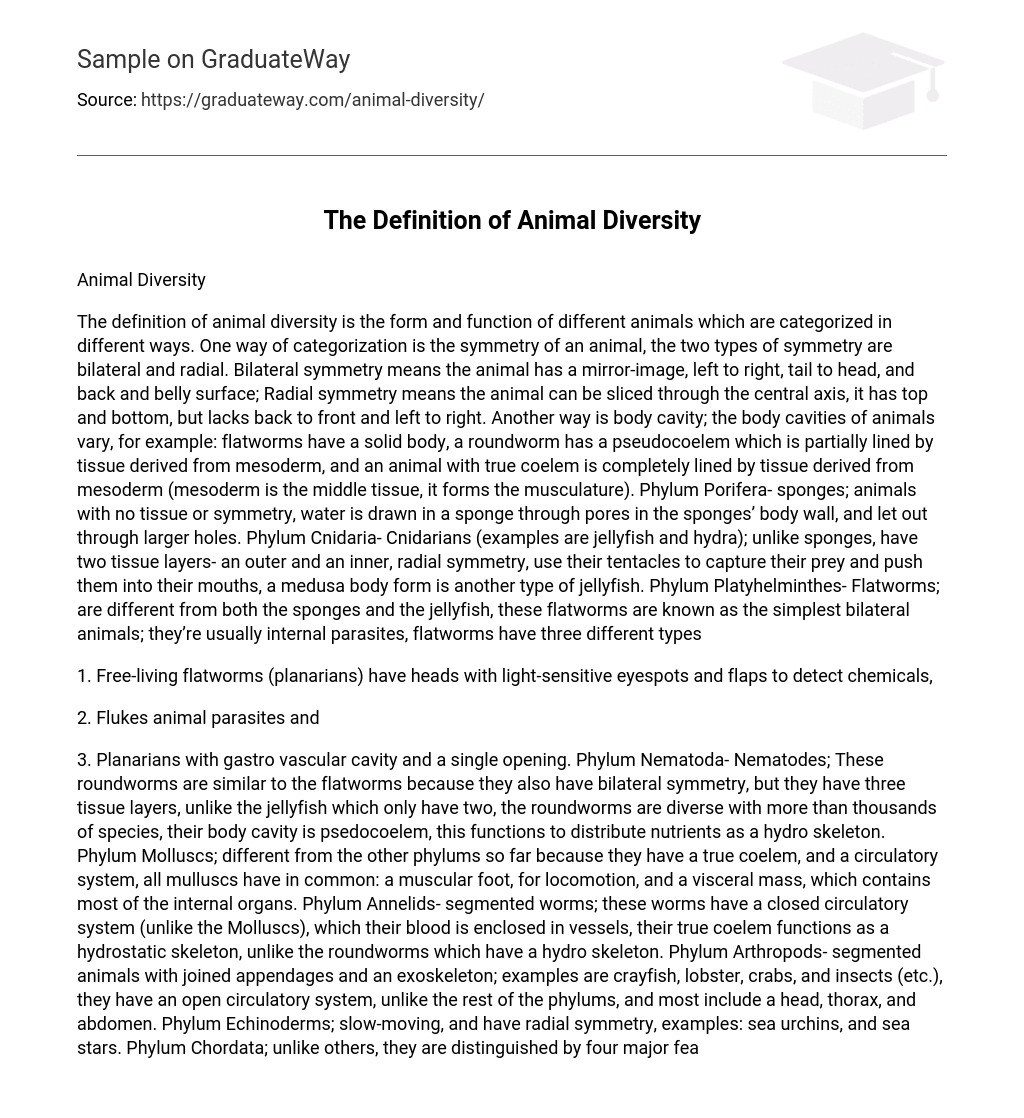Animal Diversity
The definition of animal diversity is the form and function of different animals which are categorized in different ways. One way of categorization is the symmetry of an animal, the two types of symmetry are bilateral and radial. Bilateral symmetry means the animal has a mirror-image, left to right, tail to head, and back and belly surface; Radial symmetry means the animal can be sliced through the central axis, it has top and bottom, but lacks back to front and left to right. Another way is body cavity; the body cavities of animals vary, for example: flatworms have a solid body, a roundworm has a pseudocoelem which is partially lined by tissue derived from mesoderm, and an animal with true coelem is completely lined by tissue derived from mesoderm (mesoderm is the middle tissue, it forms the musculature). Phylum Porifera- sponges; animals with no tissue or symmetry, water is drawn in a sponge through pores in the sponges’ body wall, and let out through larger holes. Phylum Cnidaria- Cnidarians (examples are jellyfish and hydra); unlike sponges, have two tissue layers- an outer and an inner, radial symmetry, use their tentacles to capture their prey and push them into their mouths, a medusa body form is another type of jellyfish. Phylum Platyhelminthes- Flatworms; are different from both the sponges and the jellyfish, these flatworms are known as the simplest bilateral animals; they’re usually internal parasites, flatworms have three different types
1. Free-living flatworms (planarians) have heads with light-sensitive eyespots and flaps to detect chemicals,
2. Flukes animal parasites and
3. Planarians with gastro vascular cavity and a single opening. Phylum Nematoda- Nematodes; These roundworms are similar to the flatworms because they also have bilateral symmetry, but they have three tissue layers, unlike the jellyfish which only have two, the roundworms are diverse with more than thousands of species, their body cavity is psedocoelem, this functions to distribute nutrients as a hydro skeleton. Phylum Molluscs; different from the other phylums so far because they have a true coelem, and a circulatory system, all mulluscs have in common: a muscular foot, for locomotion, and a visceral mass, which contains most of the internal organs. Phylum Annelids- segmented worms; these worms have a closed circulatory system (unlike the Molluscs), which their blood is enclosed in vessels, their true coelem functions as a hydrostatic skeleton, unlike the roundworms which have a hydro skeleton. Phylum Arthropods- segmented animals with joined appendages and an exoskeleton; examples are crayfish, lobster, crabs, and insects (etc.), they have an open circulatory system, unlike the rest of the phylums, and most include a head, thorax, and abdomen. Phylum Echinoderms; slow-moving, and have radial symmetry, examples: sea urchins, and sea stars. Phylum Chordata; unlike others, they are distinguished by four major features, a hollow nerve cord, a flexible supportive notochord, pharyngeal slits, and a muscular post-anal tail.





